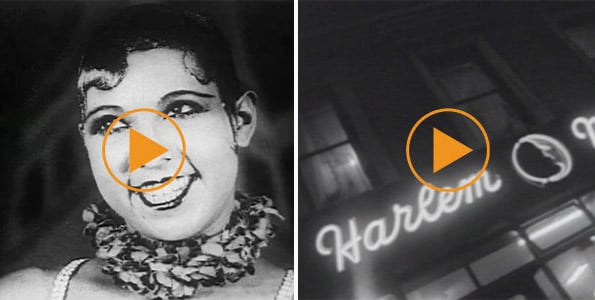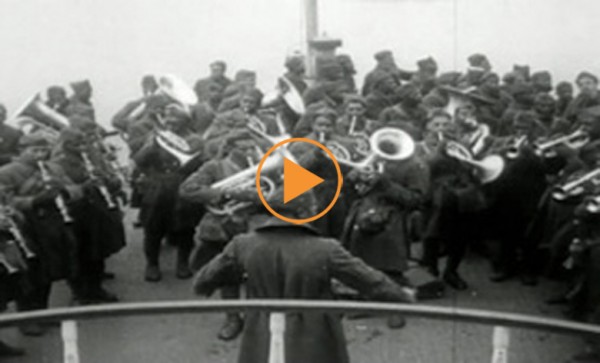
Black History Month
Observed annually in the US (in February) and the UK (in October), Black History Month remembers the pivotal events and pioneering individuals in the history of the world’s African diaspora. Our historical footage archive documents African-American civil rights campaigns, as well as communities and artists from throughout the 20th century.
In combat
Although the U.S. armed forces remained segregated through World War I, many African Americans eagerly volunteered to join the Allied cause following America’s entry into the war. By the War’s end, over 350,000 African Americans had served with the American Expeditionary Force on the Western Front. One of the most distinguished African American units was the 369th Infantry Regiment, known as the “Harlem Hellfighters“, which was on the front lines for six months – longer than any other American unit. 171 members of the 369th were awarded the Legion of Merit.
African American soldiers played a huge part in subsequent wars of the 20th century, including the Vietnam War, in which the US’s involvement was strongly opposed by civil rights leader Martin Luther King Jr. In 1967, he called the U.S. government “the greatest purveyor of violence in the world today.”
“Nonviolence is a powerful weapon. It is a sword that heals.”
– Martin Luther King Jr.
In protest
The 1960s proved to be a decade of great social change for African Americans, largely due to the impact of Luther King Jr, and his belief in nonviolent civil disobedience.
In 1963, Luther King helped organise one of the largest political rallies for human rights in United States history: the March on Washington. Peacefully calling for civil and economic rights for African Americans, it took place in Washington, D.C. on Tuesday August 27, 1963. The next day, Martin Luther King, standing in front of the Lincoln Memorial, delivered his historic “I Have a Dream” speech in which he called for an end to racism. The march is credited with helping to pass the Civil Rights Act of 1964 and motivating the Selma to Montgomery marches.
On March 7th 1965, state troopers violently attacked peaceful demonstrators led by Luther King, as they tried to cross the Pettus Bridge in Selma, Alabama. 50 marchers were hospitalised on what became known as ‘Bloody Sunday,’ after police used tear gas, whips, and clubs to force them back. After two failed attempts, and protected by 2,000 members of the US Army, protesters successfully reached Montgomery. The achievement is considered the peak of the American civil rights movement and the catalyst for pushing through the Voting Rights Act five months later.
“There will be no prison which can hold our movement down.”
– Huey P. Newton
Believing that Luther King’s non-violent campaign had failed, Huey P. Newton and Bobby Seale founded the Black Panther Party, nearly 50 years ago in October 1966. The revolutionary black-nationalist and socialist organisation used a significantly more aggressive language and stance to instigate a “revolutionary war” on authority, in defence of African-Americans and all other minority groups. In their pursuit of equality in education, housing, employment and civil rights, the Black Panthers famously proposed a ten-point program, but faced constant backlash, imprisonment and infiltration from the FBI, which eventually crippled the Party and led to its dissolution in 1982.
In Harlem
“Negro life is seizing its first chances for group expression and self determination.” – Alain leRoy Locke, 1926
Known at the time as the New Negro Movement, the Harlem Renaissance flourished in the 1920s and ‘30s. This Harlem-based literary, artistic, and intellectual movement fostered a new black cultural identity, and redefined how the USA, and the world, viewed African Americans. This identity led to a new spirit of self-determination, putting them on the world stage, both in terms of popular entertainment, and as a foundation to build upon for the Civil Rights struggles in the 50s and 60s. Performer and activist Josephine Baker became known as a player in both the pop culture and political arenas.
In the decades following this unprecedented outpouring of artistic work by the American black community, Harlem, with its jazz club lined streets and legendary performances, became the epicentre of African American music, while seeing everything from poverty to urban growth.

Left: Josephine Baker/ Stars of stage and screen
Right: Neon lights of bars and restaurants at night, Harlem c.1962
Find out more:
Read more about the Selma to Montgomery marches
See all images and footage of the Selma to Montgomery marches
Contact the Bridgeman Sales Team at uksales@bridgemanimages.com for more information on licensing these clips.
Save



